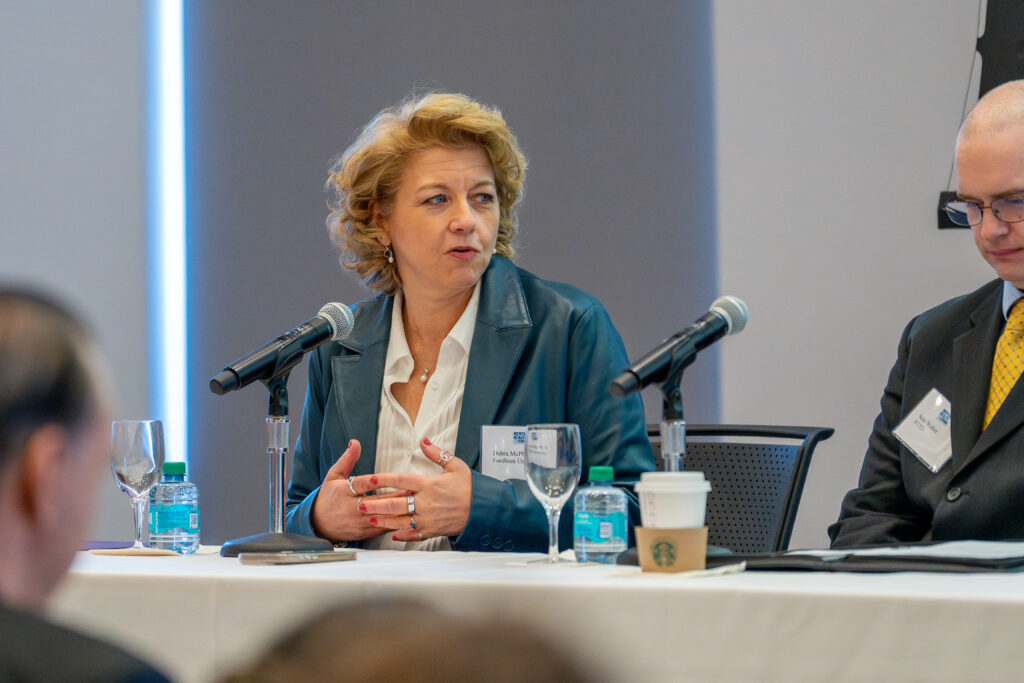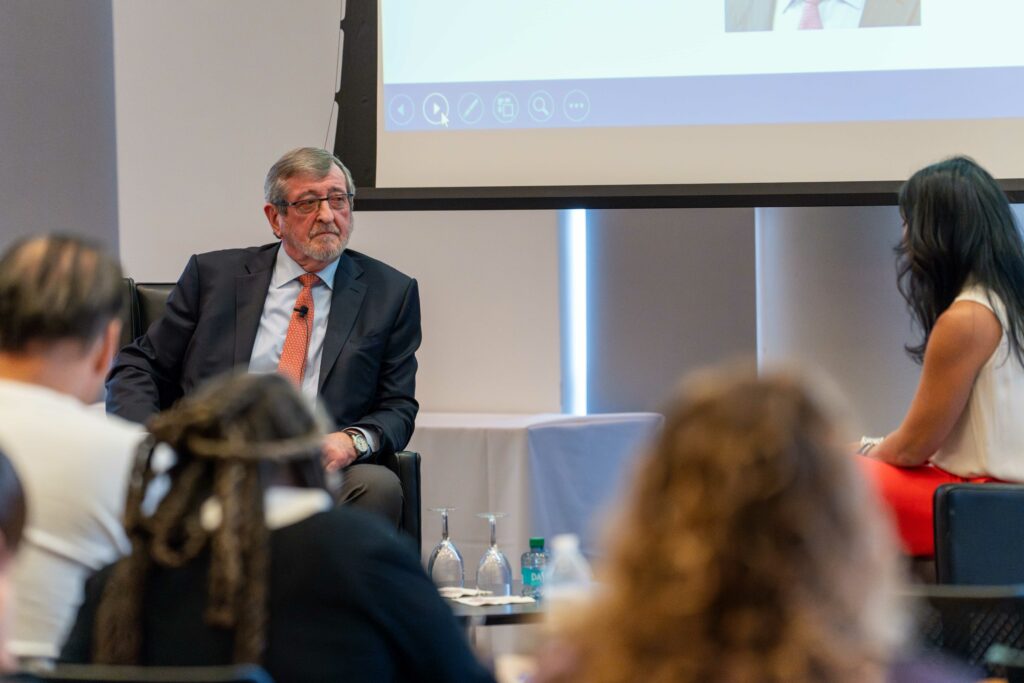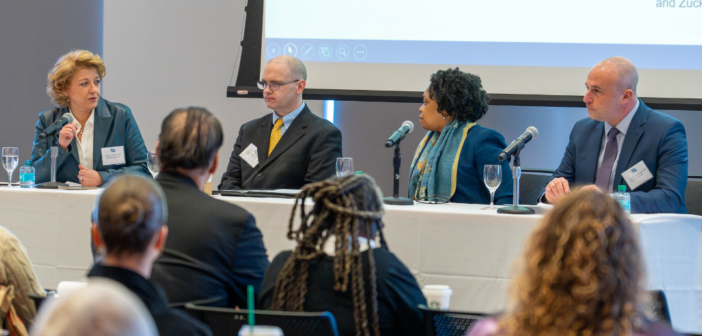What exactly happens after someone calls 9-1-1 following a mental-health-related incident? What infrastructure do we have to ensure the criminal justice and mental health systems can collaborate for the situation’s best outcome? How do we know what we’re doing is working, and what can we do to improve?
These were some of the questions tackled at Fordham University’s interdisciplinary conference “Mental Health & Crime: A Path to Safety for All,” held on Thursday, January 16, at Fordham’s Law School. Three members of the Fordham GSS Community contributed to the day’s discussion:
- Debra M. McPhee, Ph.D., Dean of the Graduate School of Social Service
- Hon. Richard M. Berman, GSS ’96, Senior United States District Judge of the United States District Court for the Southern District of New York
- Michael Dowling, GSS ’74, President and CEO, Northwell Health
Together, expert practitioners from the criminal justice, mental health, legal, and academia sectors explored ways to improve outcomes, enhance public safety, and provide an actionable path forward to this critical challenge.
When the Call Comes In: 9-1-1 Emergency Response
To illustrate the system’s intricacies, the conference timeline traced a hypothetical emergency mental health scenario, beginning with the initial call to 9-1-1. Moderated by McPhee, the introductory panel featured Monica Booker, Assistant Commissioner of the Behavioral Health Division, Co-Response, NYPD; Michel Greenspan, M.D., Forensics Psychiatrist and Program Director of the Psychiatry Residency Training Program at the Donald and Barbara Zucker School of Medicine at Hofstra/Northwell and Zucker Hillside Hospital; and Lieutenant Sean Walker, Operations Coordinator at the Interagency Operations Bureau, NYPD.
Approximately 8 million 9-1-1 calls are made each year in NYC, and in 2024, 168,000 of them were mental-health-related, Walker said. A medley of challenges accompanies these calls:
- Information Asymmetry: 9-1-1 operators work with limited information and must decipher the emergency within seconds to ensure a quick response. 9-1-1 is designed to send help, Walker said, not complete a mental health assessment.
- Split-Second Triage: Mental health calls have a broad range, and police must rapidly reconcile what response is needed.
- Lack of Alternatives: If police are needed at the scene, although they do have de-escalation training, there is not much they can do but send the person to the hospital with EMS, Walker said.

Dean Debra M. McPhee, Ph.D.
If there is any suspected danger at the scene, Walker continued, police must show up. However, in so-called “low-acuity” or non-dangerous situations, on-site EMS workers can decide it is a “B-HEARD” call, and police aren’t needed.
Booker said the B-HEARD program provides a welcomed caseload reduction for the NYPD. But are there enough mental health professionals to meet the need? Booker isn’t sure. As someone who has licensed social workers on her team, Booker says there is still a shortage of individuals who want to do this work.
“There are not enough mental health providers, from psychiatry to social workers,” Booker said.
However, she added that Master of Social Work programs like the one at Fordham are introducing upstart professionals to these roles through hands-on field placements, and the feedback has been positive.
“Fordham has an amazing program, and where we give our internships matters,” she said. “Many social workers like the placement.”

From left to right: Fordham GSS Dean Debra M. McPhee, Ph.D.; Lieutenant Sean Walker, Operations Coordinator at the Interagency Operations Bureau, NYPD; Monica Booker, Assistant Commissioner of the Behavioral Health Division, Co-Response, NYPD; Michel Greenspan, M.D., Forensics Psychiatrist and Program Director of the Psychiatry Residency Training Program at the Donald and Barbara Zucker School of Medicine at Hofstra/Northwell and Zucker Hillside Hospital
Once the individual has been brought to the emergency room—if that is the appropriate protocol for the specific situation—the intake process can be challenging, Greenspan said. Police must remain with the individual if they have been arrested, and although the NYPD turns their cameras and other recorders off for the individual’s privacy, the police presence can still cause hesitation.
“It can be uncomfortable with someone else in the room,” Greenspan said. “It keeps them [the arrested individual]at an arm’s distance.”
This can lead to a broader strife between police and mental health professionals, Booker said. In the Co-Reponse division, she places a priority on “building trust throughout the continuum” in a system that, she said, has become increasingly polarized since George Floyd’s murder in 2020.
“The police are trying to manage risk, and the clinicians are thinking about the individual on a deeper level,” she said. “We need to build relationships around respect.”
Booker confessed that metrics measuring assessment outcomes are lacking in this space. Most performance indicators center around engagement, and Booker cites obtaining post-intake information as a major challenge to efficient measurement. Greenspan offered a glimmer of hope but agreed that this is one area where improvement is desperately needed.
“The attitudinal data is there,” he said. “But we don’t really have data to say one way or the other.”
A Judge’s Role in Community Reentry
After serving a sentence in federal prison, one of the last people you want to see when you are released is the judge who put you there. However, Hon. Richard M. Berman is proving that court-involved supervised release comes with impressive positive outcomes—particularly when the judge is involved.
According to an essay Berman wrote for the Regulatory Review in 2021, a federal criminal sentence typically also includes a term of “supervised release,” which the U.S. Sentencing Commission defines as a “unique type of post-confinement monitoring that is overseen by federal district courts with the assistance of federal probation officers.” Supervised release is intended to assist people who have served prison terms with their effective reintegration into the community.
In most cases, judges are not involved in the supervised release process. Typically, probation officers are responsible for overseeing supervision. Berman, however, is not your typical judge. He’s also a trained social worker.

Hon. Richard M. Berman, GSS ’96
Thus, Berman has taken an active and engaged role in the supervised release of individuals he has sentenced to time in prison. The individuals come back to his courtroom within 30 days of release, and Berman holds monthly hearings to ensure they are being properly acclimated to rejoining the community. Alongside Berman and the individuals, the hearings are attended by the defense attorney, the Assistant US attorney, and most importantly, Berman said, the individual’s therapist or drug counselor.
Understandably, some individuals are not thrilled about the situation.
“One man once came back [to Berman’s courtroom]after nine years of incarceration,” Berman said. “And he said, ‘Not you again.’”
However, the results speak for themselves. In Berman’s 2021 report detailing his supervised release of 152 individuals between 2016 and 2020, the study found that “increased judicial involvement in supervised release meaningfully can help supervisees with successful reentry, as measured by such factors as fewer felony arrests and serious probation violations.”
“We’re setting the stage for reentry and being of help,” Berman said. “We’ve had some terrific successes.”
Leading the Future of Health Care
All of the work invested into the health care system today is wasted if we don’t take the time to educate the profession’s future. Thanks to people like Michael Dowling, that future looks bright.
Before becoming the CEO of Northwell Health, the largest health care provider and employer in New York State, Dowling cut his teeth in many different sectors. His time as a young man working on docks and in construction eventually led to positions as a professor and dean at the Graduate School of Social Service, and time spent working in government. His government tenure often “threw me in the deep end of the pool,” he said, which allowed him to quickly learn skills and perspectives crucial to his professional development.
“Working in government gives you a broader view of the world, for good and bad,” he said.

Michael Dowling, GSS ’74
At the conference, Dowling advocated for a holistic approach to health care that intertwines mental and physical health for better outcomes. Colocated care reduces the stigma around mental health, Dowling said, by making clear that it is a full component of health—just as important as our heart and muscles.
Northwell has taken considerable action toward this vision. In 2023, it launched a $500M initiative to expand pediatric mental health services and access to care, which includes building a preeminent center of mental health excellence that will bridge the gap between physical and mental health services for children. The approximately 200,000-square-foot building will “fully integrate physical and mental health care for children and serve as a destination program for patients across the country.”
In addition, Northwell is proactively educating the profession’s future. Northwell is involved in 80 high schools through mental health crisis teams, and is even opening a high school of its own in September 2025. Northwell High School of Health Sciences will boast a curriculum with pathways for behavioral and mental health, nursing, medical assisting, and health care management. The school will house 900 students, guaranteeing apprenticeships and post-graduate employment for each student.
Dowling added that this investment comes at a vital point in adolescent mental health across the nation. He attributed social media’s popularity among youth as an accelerator of mental health issues such as anxiety, depression, and suicide—concluding that all in attendance commit to doing the right thing by those who are suffering.
“The reason you’re in this room is because you care,” Dowling said, addressing the audience. “We all have a debt of gratitude to those on the ground working with these individuals.”



